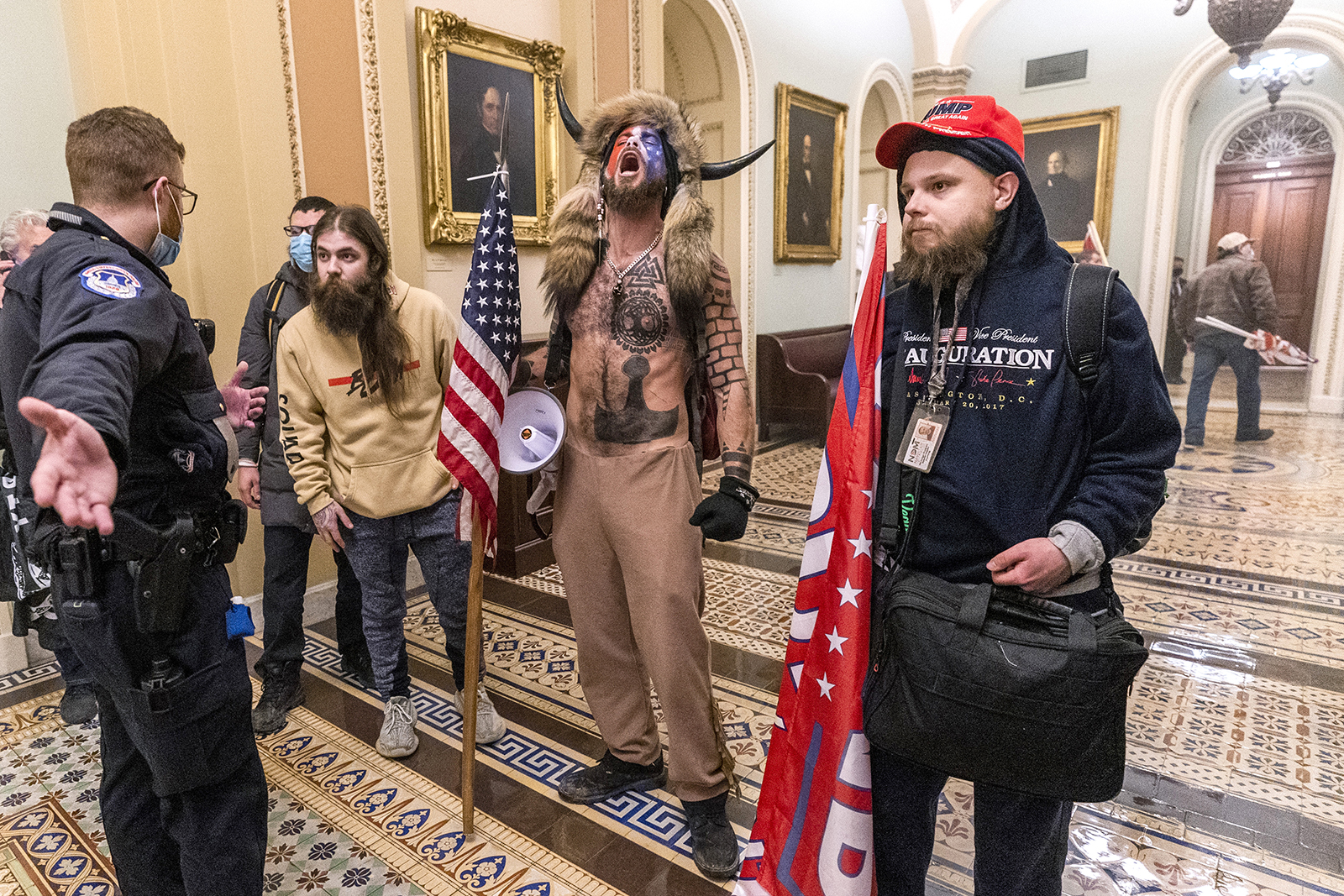
(RNS) — The photos from the Jan. 6 riot at the U.S. Capitol have shown us a particular kind of white cultural identity at play: MAGA hats, flannel and camouflage patterns, Confederate flags. They show a colorful confluence of violent imagery, masculinity and Christian-themed nationalism.
But there was another subtle marker of whiteness present on Jan. 6.
Enthusiasm for yoga.
The day before he allegedly entered the Capitol, certified yoga instructor Noah Bacon wrote on his Instagram account that “the crime of a fraudulent election is complete … 93 people are going to jail for Seditious Conspiracy and High Treason for certifying a fraudulent election … People in for a surprise.”
Not what we might expect from the yogi who says on his personal website, “I believe in, and see continual evidence for, a shared human awareness that we express in unique ways, but that is the same at heart.”
A post by another alleged Capitol rioter, Alan Hostetter, a California police chief turned yoga instructor, is full of blistering, conspiracy-laden rhetoric about COVID-19 restrictions and false claims about a “stolen” election. Claiming he is the only credible source of information regarding both the pandemic and election, Hostetter exhorts wealthy white members of an Orange County yoga community to revolt against the federal government.
Better known as the “QAnon shaman,” Jacob Chansley left a threatening note for Mike Pence and wielded a spear-tipped flag while strolling about the Capitol in January. Yet Chansley’s lawyers have portrayed him as “a lover of nature,” who is an “active practitioner of yoga” and an adherent of Jesus and Gandhi.
We should not be surprised, however, to find so many self-described yogis among the Capitol rioters. Yoga in the United States is intertwined with wealth, whiteness and white supremacy, perhaps a shock to many of its casual practitioners.

Jacob Chansley, center, better known as the “QAnon Shaman,” and other supporters of President Donald Trump are confronted by Capitol Police officers outside the Senate Chamber inside the Capitol, Jan. 6, 2021, in Washington. (AP Photo/Manuel Balce Ceneta)
In Chansley’s case, offering practicing yoga and claiming to be shaman as evidence that he was not engaged in violence are learned tactics that leverage perceptions of Asians as inherently peaceful. The argument that being aligned with Gandhi and performing yoga poses renders his presence in the Capitol peaceful is, well, a stretch.
It also shows how he and others co-opt yoga not as a spiritual discipline but as “a practice which allows Western practitioners to experience the idea of another culture while focusing on the self,” as Michigan State religious studies professor Shreena Gandhi and her co-author Lillie Wolff point out in an influential 2017 article “Yoga and the Roots of Cultural Appropriation.”
This explains why, while in police custody, Chansley blithely demanded organic food for “religious reasons” and release from confinement due to mental illness. This isn’t the logic of partisanship or Trumpism: it is the logic of whiteness and specifically the capitalist, globalized wellness industry that allows what Gandhi and Wolff call “the yoga industrial complex” to flourish.
In other words, we shouldn’t confuse Americans’ adoption of yoga as at odds with attending a white supremacist riot — especially given how many yoga studios in the U.S. center whiteness and wealth and rely on Asian absence to be successful.
Chansley’s “yoga defense” in fact exemplifies the “me”-centeredness that defines the Jan. 6 crowd.
Hostetter, too, advocates for unchecked individualism. Conspiracy theories and extremism have found a receptive audience in the wellness industry, perhaps because both communities view mainstream sources of information skeptically and find their own anecdotal experience more persuasive. A speaker at a QAnon conference, former police officer and yoga instructor, Hostetter also embodies the cross-section of identities present at the Capitol building.
What these groups have in common is a shared investment in individual choice. The Jan. 6 riot was a defense of privilege and was grounded in the core tenets of American capitalism: individualism, access, choice. These are all the fruits of the social capital of whiteness. The fact that Bacon, Chansley, or Hostetter tout their distrust of this system doesn’t stop them from leveraging their privilege within it.
Does this mean all yogis are extremists and white supremacists?
No. Rather, the not-so-insignificant number of self-described yogis among the Capitol rioters only shows that so-called liberal v. conservative polarity is a flawed way to understand what happened at the Capitol. Affluence, whiteness, power and access are far better metrics by which to analyze how we got to Jan. 6.
This column is produced by Religion News Service with support from the Guru Krupa Foundation.
(Dheepa Sundaram is an assistant professor of religious studies at the University of Denver who writes about digital culture, yoga, nationalism and religion. The views expressed in this commentary do not necessarily reflect those of Religion News Service.)
